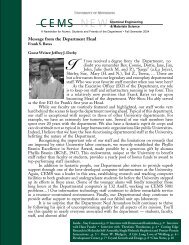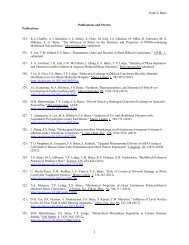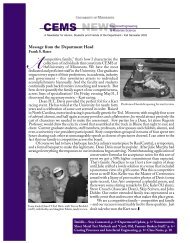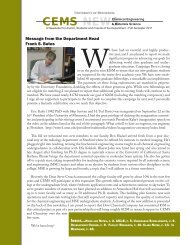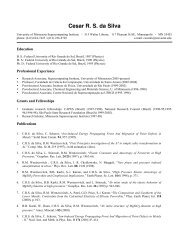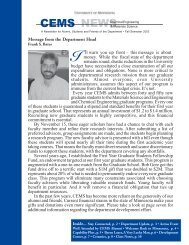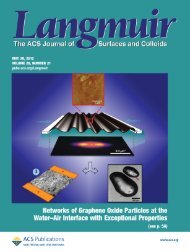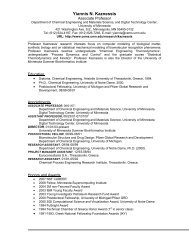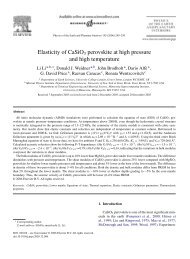A Salute to the WWII Pioneers in the Petroleum Refining ... - CEMS
A Salute to the WWII Pioneers in the Petroleum Refining ... - CEMS
A Salute to the WWII Pioneers in the Petroleum Refining ... - CEMS
You also want an ePaper? Increase the reach of your titles
YUMPU automatically turns print PDFs into web optimized ePapers that Google loves.
A <strong>Salute</strong> <strong>to</strong> <strong>the</strong> <strong>WWII</strong> <strong>Pioneers</strong> <strong>in</strong> <strong>the</strong> <strong>Petroleum</strong> Ref<strong>in</strong><strong>in</strong>g & Chemical Industries<br />
by G. T. Westbrook,<br />
<strong>WWII</strong> came <strong>to</strong> an end over 60 years ago. There have been many appropriate<br />
tributes <strong>to</strong> <strong>the</strong> veterans who gave so much <strong>to</strong> help this cause. Less noted—<strong>in</strong>deed almost<br />
unnoted—were <strong>the</strong> <strong>in</strong>credible contributions made by <strong>the</strong> many communities <strong>in</strong> <strong>the</strong><br />
petroleum ref<strong>in</strong><strong>in</strong>g and chemical <strong>in</strong>dustries. In this report key efforts from <strong>the</strong>se<br />
<strong>in</strong>dustries will be noted and a salute given <strong>to</strong> <strong>the</strong> pioneers <strong>in</strong> <strong>the</strong>se areas who contributed<br />
so much <strong>to</strong> <strong>the</strong> successful completion of <strong>WWII</strong>. While it surely would be <strong>in</strong>appropriate<br />
<strong>to</strong> overstate <strong>the</strong> contributions from this sec<strong>to</strong>r, it may well be that this was <strong>the</strong> most<br />
important supply effort of all <strong>in</strong>dustries and government programs. Without a successful<br />
fulfillment of <strong>the</strong> missions assigned, <strong>WWII</strong> would have ended much differently.<br />
Three <strong>in</strong>terrelated programs will be reviewed briefly namely aviation gasol<strong>in</strong>e<br />
(AGN), tr<strong>in</strong>itro<strong>to</strong>luene (TNT) and styrene butadiene rubber (SBR). Through a<br />
comb<strong>in</strong>ation of fac<strong>to</strong>rs—outstand<strong>in</strong>g research and eng<strong>in</strong>eer<strong>in</strong>g – particularly consider<strong>in</strong>g<br />
<strong>the</strong> conditions and <strong>the</strong> <strong>to</strong>ols available; classic American <strong>in</strong>genuity – <strong>to</strong> beg borrow or<br />
steal a component here or a blend-s<strong>to</strong>ck <strong>the</strong>re; classic American creativity – <strong>to</strong> f<strong>in</strong>d a<br />
solution when none seemed <strong>to</strong> exist; and f<strong>in</strong>ally m<strong>in</strong>d numb<strong>in</strong>g hours of effort <strong>in</strong> horrible<br />
conditions—<strong>the</strong> pioneers of <strong>the</strong>se <strong>in</strong>dustries got <strong>the</strong> job done. Not only did <strong>the</strong>y solve <strong>the</strong><br />
challenges <strong>in</strong> <strong>the</strong> above three fields, but <strong>in</strong> do<strong>in</strong>g so <strong>the</strong>y literally gave birth <strong>to</strong> <strong>the</strong> process<br />
<strong>in</strong>dustries that we know <strong>to</strong>day.<br />
Hitler's ambitions surfaced with <strong>the</strong> re-occupation of <strong>the</strong> Rh<strong>in</strong>eland <strong>in</strong> March of<br />
1936, followed by moves <strong>in</strong><strong>to</strong> Austria, Czechoslovakia and Poland. The <strong>in</strong>vasion of<br />
Poland, <strong>in</strong> September of 1939, triggered UK and France <strong>to</strong> declare war. In January of<br />
1940, FDR <strong>in</strong>itiated a major preparedness program. Then <strong>in</strong> May, 1940, Germany<br />
<strong>in</strong>vaded <strong>the</strong> Lowlands and France. With <strong>the</strong> fall of France <strong>in</strong> June, FDR asked Congress<br />
<strong>to</strong> double his prior plan, <strong>in</strong>clud<strong>in</strong>g rais<strong>in</strong>g annual plane production from 5000 <strong>to</strong> 50,000.<br />
The Battle of Brita<strong>in</strong> began <strong>in</strong> August, 1940. It was here that <strong>the</strong> critical role for AGN<br />
first emerged for "without 100 octane, we should not have won <strong>the</strong> Battle of Brita<strong>in</strong>. “It is<br />
a fact that this high performance fuel, spiked with aromatics such as cumene, gave British<br />
Spitfires and Hurricanes a dist<strong>in</strong>ct advantage over <strong>the</strong> much larger planes of <strong>the</strong><br />
Luftwaffe." If this battle had been lost, it would have had major impact on <strong>the</strong> future of<br />
<strong>WWII</strong>.<br />
By December 1941, <strong>the</strong> Japanese military activity on <strong>the</strong> Asian ma<strong>in</strong>land, had<br />
been underway for years. But few, if any, predicted Japan's <strong>in</strong>terests extended as far east<br />
as Pearl Harbor. After that vic<strong>to</strong>ry, Japan's forces rapidly moved—<strong>in</strong><strong>to</strong> <strong>the</strong> Philipp<strong>in</strong>es,<br />
<strong>the</strong> British East Indies, and <strong>the</strong> Ne<strong>the</strong>rlands East Indies—and seized control of <strong>the</strong> natural<br />
rubber plantations. A critical need for syn<strong>the</strong>tic rubber was at hand. Fortunately <strong>the</strong> U.S.<br />
had built a significant <strong>in</strong>ven<strong>to</strong>ry of natural rubber. Equally fortunate was that a syn<strong>the</strong>tic<br />
rubber, namely SBR, was <strong>in</strong> <strong>the</strong> pilot plant stage. This rubber, sometimes called BUNA-S<br />
(BU from butadiene, NA from <strong>the</strong> sodium catalyst used, and S for styrene), filled <strong>the</strong><br />
lions share of <strong>WWII</strong> rubber requirements.<br />
The Doolittle raid on Japan <strong>in</strong> April 1942, and <strong>the</strong> vic<strong>to</strong>ry at Midway, <strong>in</strong> June<br />
1942, once aga<strong>in</strong> emphasized <strong>the</strong> need for AGN. This was fur<strong>the</strong>r highlighted over <strong>the</strong><br />
many island hopp<strong>in</strong>g campaigns that followed. "The addition of substituted aromatics <strong>to</strong>
aviation gasol<strong>in</strong>e would give a fuel – which was desirable for high power takeoffs on<br />
short runways and aircraft carriers." In November 1944, <strong>the</strong> first B-29 raid from Saipan<br />
occurred. Unlike <strong>the</strong> strikes <strong>in</strong> Europe, <strong>the</strong>se were long, roughly a 3000 mile round trip,<br />
and would require a major boost <strong>in</strong> AGN supply. Indeed <strong>the</strong>se flights were so long <strong>the</strong><br />
U.S. went after Iwo Jima, <strong>in</strong> part, for an emergency land<strong>in</strong>g strip for <strong>the</strong> return flights.<br />
The supply of materials of all types would thus play crucial roles <strong>in</strong> both <strong>the</strong>aters.<br />
One can imag<strong>in</strong>e <strong>the</strong> confusion, even panic <strong>in</strong> London and Wash<strong>in</strong>g<strong>to</strong>n, as <strong>the</strong> supply<br />
needs became clearer. Stagger<strong>in</strong>g scale up efforts were go<strong>in</strong>g <strong>to</strong> be needed. These efforts<br />
would have <strong>to</strong> be achieved with marg<strong>in</strong>al communication systems; terrible transportation<br />
facilities; ugly lodg<strong>in</strong>g options; zero computers and zero l<strong>in</strong>ear programs – <strong>the</strong> computer<br />
systems that plan and schedule ref<strong>in</strong>eries <strong>to</strong>day. Shortages existed not only <strong>in</strong> fuels and<br />
chemicals, but for materials of all types: metals for tanks, guns, ships and planes, plus<br />
pumps, pipes, <strong>to</strong>wers and so on; plastics, <strong>to</strong> save metals; rubber for tires, hoses and belts;<br />
pa<strong>in</strong>ts for all types of hostile arenas; and sealants for ignition systems, and <strong>to</strong> seal radar<br />
units.<br />
Magnesium for war planes is an <strong>in</strong>terest<strong>in</strong>g, but not untypical example of <strong>the</strong> huge<br />
scale-up efforts required. Government <strong>in</strong>terest <strong>in</strong> magnesium was close <strong>to</strong> zero. This<br />
changed when it was discovered that German planes owed a great deal of <strong>the</strong>ir speed, and<br />
<strong>the</strong>ir capacity <strong>to</strong> carry fuel and bombs, <strong>to</strong> weight sav<strong>in</strong>gs via liberal use of this metal.<br />
Initially mag use amounted <strong>to</strong> about 80 pounds per plane. By <strong>the</strong> end of <strong>the</strong> war this unit<br />
consumption had become about 2000 pounds. With <strong>the</strong> annual output set <strong>to</strong> grow from<br />
5000 planes <strong>to</strong> FDR's goal of 50,000 (that actually hit 125,000), mag use exploded from<br />
near zero <strong>to</strong> 4 million pounds per year (MMPPY), <strong>the</strong>n <strong>to</strong> 250 MMPPY.<br />
Supply of chemicals had one of <strong>the</strong> major material <strong>in</strong>teractions of <strong>the</strong> war,<br />
namely competition for <strong>the</strong> aromatics benzene and <strong>to</strong>luene. AGN, like all gasol<strong>in</strong>e, is<br />
made from many blend-s<strong>to</strong>cks <strong>in</strong>clud<strong>in</strong>g aromatics, such as <strong>to</strong>luene, ethylbenzene (EB)<br />
and cumene. These were particularly useful blend-s<strong>to</strong>cks. But <strong>the</strong> ma<strong>in</strong> role for <strong>to</strong>luene<br />
was TNT. And <strong>the</strong> ma<strong>in</strong> role for benzene was ethylbenzene for styrene and hence SBR.<br />
Once <strong>the</strong> grow<strong>in</strong>g needs for SBR and TNT were met <strong>the</strong> excess would be used <strong>in</strong> AGN:<br />
<strong>to</strong>luene directly and benzene via ei<strong>the</strong>r EB or cumene.<br />
In 1939, benzene and <strong>to</strong>luene came from liquids recovered from coke ovens as<br />
part of steel production. Output of benzene was about 125 million gallons per year<br />
(MMGPY), with an expected doubl<strong>in</strong>g needed. This scale-up could be handled by <strong>the</strong><br />
coke ovens. The situation for <strong>to</strong>luene was different. Current output was around 25<br />
MMGPY, but <strong>the</strong> expected <strong>in</strong>crease was ten fold, and that could not be obta<strong>in</strong>ed from<br />
<strong>the</strong>se ovens. A new source for <strong>to</strong>luene would be needed.<br />
The AGN program had <strong>to</strong> produce a mix of ra<strong>the</strong>r complex fuels. AGN is a high<br />
octane, controlled vapor pressure fuel for propeller based planes. In 1939, with mo<strong>to</strong>r<br />
gasol<strong>in</strong>e at about 75 octane, AGN requirements would range from as low as 87 for <strong>the</strong><br />
simplest reconnaissance plane up-<strong>to</strong> and even above 100 octane, for high performance<br />
fighters and bombers.<br />
In 1939 <strong>the</strong> U.S. AGN capacity was about 17 thousand barrels per day (MBPD).<br />
Early <strong>in</strong> 1941 forecasts were at 35 MBPD, but after Pearl Harbor, <strong>the</strong>se jumped <strong>to</strong> 190<br />
MBPD. A year later <strong>the</strong>y grew aga<strong>in</strong> <strong>to</strong> 300 MBPD. F<strong>in</strong>ally, <strong>in</strong> 1945, AGN capacity<br />
peaked out at over 600 MBPD.
A strategy was developed <strong>to</strong> meet <strong>the</strong>se chang<strong>in</strong>g requirements. Efforts were <strong>to</strong> be<br />
divided between a major construction program and a "Quick 100" program. This latter<br />
effort consisted of operational changes, small construction projects and blend<strong>in</strong>g policy<br />
changes. All of <strong>the</strong>se could be accomplished relatively rapidly, but would <strong>in</strong>volve<br />
changes <strong>in</strong> over 300 relatively small ref<strong>in</strong>eries.<br />
Operational changes would <strong>in</strong>clude such activities as: search<strong>in</strong>g ref<strong>in</strong>eries for high<br />
octane straight run blend s<strong>to</strong>cks; coord<strong>in</strong>at<strong>in</strong>g <strong>in</strong>ter-plant blend-s<strong>to</strong>ck moves; maximiz<strong>in</strong>g<br />
cracked gasol<strong>in</strong>e output for AGN base and allocat<strong>in</strong>g more feed-s<strong>to</strong>ck <strong>to</strong> alkylation units<br />
for more alkylate output. Part of alkylate would be 2,2,4-trimethyl pentane, a chemical<br />
that sets <strong>the</strong> upper, 100 octane, standard.<br />
The small construction program <strong>in</strong>cluded: de-bottleneck<strong>in</strong>g ref<strong>in</strong>ery units<br />
extensively; convert<strong>in</strong>g 72 polymer gasol<strong>in</strong>e units <strong>to</strong> co-dimer units, followed<br />
by hydrogenation at four major, central hydrogenation plants. (This would produce a<br />
blend-s<strong>to</strong>ck much like alkylate, called hydro-co-dimer); convert<strong>in</strong>g an additional 18<br />
polymer gasol<strong>in</strong>e units <strong>to</strong> produce cumene; and f<strong>in</strong>ally add<strong>in</strong>g distillation <strong>to</strong>wers <strong>to</strong><br />
extract high octane isopentane from ref<strong>in</strong>ery or gas plant streams.<br />
The blend<strong>in</strong>g policy changes <strong>in</strong>cluded: blend<strong>in</strong>g <strong>in</strong> <strong>to</strong>luene <strong>to</strong> <strong>the</strong> extent <strong>the</strong> TNT<br />
program could spare (by 1944, up-<strong>to</strong> 35% of <strong>the</strong> <strong>to</strong>luene was used <strong>in</strong> AGN); blend<strong>in</strong>g <strong>in</strong><br />
EB <strong>to</strong> <strong>the</strong> extent <strong>the</strong> SBR program could spare; and f<strong>in</strong>ally us<strong>in</strong>g extra tetraethyl lead<br />
(TEL), up <strong>to</strong> 6 cubic centimeters per gallon, roughly twice <strong>the</strong> normal practice for mo<strong>to</strong>r<br />
gasol<strong>in</strong>e at that time, and zero <strong>to</strong>day.<br />
The major construction program focused on construction of three types of units:<br />
alkylation, catalytic crack<strong>in</strong>g (cat crackers) and catalytic reform<strong>in</strong>g plants. Today, <strong>the</strong>se<br />
processes are <strong>the</strong> big ticket units <strong>in</strong> ref<strong>in</strong><strong>in</strong>g, produc<strong>in</strong>g about 6,000 MBPD of gasol<strong>in</strong>e<br />
blend-s<strong>to</strong>cks. In 1941 <strong>the</strong>y barely existed. The new reform<strong>in</strong>g processes would be <strong>the</strong><br />
route <strong>to</strong> <strong>to</strong>luene and seven units were <strong>in</strong>stalled. The new cat crackers were targeted <strong>to</strong> be<br />
<strong>the</strong> bulk source of AGN blend-s<strong>to</strong>cks. They would provide <strong>the</strong> base AGN blend-s<strong>to</strong>ck<br />
called (cat naphtha or cat gasol<strong>in</strong>e), plus added olef<strong>in</strong>s for use <strong>in</strong> o<strong>the</strong>r blend-s<strong>to</strong>cks. Sixty<br />
units were built, with a <strong>to</strong>tal feed capacity of 760 MBPD. Sixty new alkylation plants<br />
were also built, amount<strong>in</strong>g <strong>to</strong> 178 MBPD of output.<br />
The AGN program was an unquestioned success. Output, at <strong>the</strong> end of 1940, was<br />
25 MBPD, and up-<strong>to</strong> 40 MBPD by <strong>the</strong> attack on Pearl Harbor. By December 1942 it was<br />
up-<strong>to</strong> 80 MBPD, and a year later, <strong>to</strong> 240 MBPD. At <strong>the</strong> end of June 1945, production<br />
reached 650 MBPD, a 2500 % <strong>in</strong>crease from 1940. Early <strong>in</strong> 1944 "an Army General<br />
stated: 'The job which has been done with 100 octane by <strong>the</strong> ref<strong>in</strong>ery experts is one of <strong>the</strong><br />
most amaz<strong>in</strong>g th<strong>in</strong>gs I have ever witnessed. It is almost unbelievable. They have almost<br />
‘squeezed it out of a hat.'" Not only did <strong>the</strong> ref<strong>in</strong><strong>in</strong>g <strong>in</strong>dustry meet <strong>the</strong> challenges for<br />
AGN, but also for all <strong>the</strong> o<strong>the</strong>r ref<strong>in</strong>ery products required – mo<strong>to</strong>r gasol<strong>in</strong>e, diesel fuel,<br />
lube oils and greases for all sorts of hostile operat<strong>in</strong>g environments.<br />
The s<strong>to</strong>ry of TNT over <strong>WWII</strong> is really <strong>the</strong> s<strong>to</strong>ry of <strong>the</strong> development of a major<br />
new source of purity <strong>to</strong>luene. In 1933, Standard Oil Development (S.O.D. or ESSO, a<br />
precursor <strong>to</strong> Exxon) reported <strong>to</strong> <strong>the</strong> army Ordnance Department <strong>the</strong> detection of <strong>to</strong>luene<br />
<strong>in</strong> product streams from <strong>the</strong>rmal reform<strong>in</strong>g experiments on a petroleum based naphtha.<br />
While samples did not come up <strong>to</strong> nitration grade requirements, ESSO cont<strong>in</strong>ued <strong>the</strong><br />
research. By 1936 purity had improved, but not enough for <strong>the</strong> very demand<strong>in</strong>g nitration<br />
process <strong>to</strong> TNT. ESSO scientists, as a result, started <strong>to</strong> concentrate on catalytic
eform<strong>in</strong>g. This process gave much improved results over <strong>the</strong> <strong>the</strong>rmal route, and a pilot<br />
plant was built <strong>in</strong> 1938. Ultimately a 99+% <strong>to</strong>luene stream was produced which could be<br />
nitrated.<br />
With war pend<strong>in</strong>g, <strong>the</strong> Army's <strong>in</strong>terest <strong>in</strong> <strong>to</strong>luene became grave and <strong>the</strong>y ordered a<br />
first batch amount<strong>in</strong>g <strong>to</strong> 20,000 gallons. A logistics nightmare existed at that time as seen<br />
<strong>in</strong> <strong>the</strong> steps taken <strong>to</strong> fill this contract. The naphtha feed-s<strong>to</strong>cks were ref<strong>in</strong>ed <strong>in</strong> Texas.<br />
They were <strong>the</strong>n shipped <strong>to</strong> New Jersey for reform<strong>in</strong>g. This reformate stream—conta<strong>in</strong><strong>in</strong>g<br />
aromatics, aliphatics and naph<strong>the</strong>nes of <strong>the</strong> same boil<strong>in</strong>g range—was returned <strong>to</strong> Texas,<br />
<strong>in</strong> 22 tank cars, for aromatics recovery. Next <strong>the</strong> aromatics—benzene, <strong>to</strong>luene, xylenes<br />
and EB—were shipped <strong>to</strong> Louisiana for recovery and purification of <strong>to</strong>luene. F<strong>in</strong>ally <strong>the</strong><br />
<strong>to</strong>luene was shipped <strong>to</strong> Maryland for nitration.<br />
Needless <strong>to</strong> say ESSO did not make any money on this 1940 contract, but<br />
bus<strong>in</strong>ess did improve dramatically after that and Humble Oil built <strong>the</strong> Bay<strong>to</strong>wn Ordnance<br />
Works, a plant that ultimately produced more than half of <strong>the</strong> <strong>to</strong>tal supply of wartime<br />
<strong>to</strong>luene from petroleum.<br />
The SBR program. One <strong>WWII</strong> executive stated <strong>in</strong> 1944 --- "Without a doubt, <strong>the</strong><br />
most critical war material shortage was that of rubber, practically all of which had been<br />
imported." The challenge <strong>in</strong> <strong>the</strong> SBR program may best be seen by review<strong>in</strong>g <strong>the</strong> status<br />
of commercial polymer know-how <strong>in</strong> 1939. This was terribly austere. Polymer<br />
production amounted <strong>to</strong> only 200 million pounds per year (MMPPY) versus 80,000<br />
MMPPY <strong>in</strong> 1990. Polystyrene was barely out <strong>the</strong> door, and polyethylene was not<br />
commercially available. Any elas<strong>to</strong>mer production was strictly pilot plant. In order <strong>to</strong><br />
produce <strong>the</strong> large quantities of SBR that would be required, three major olef<strong>in</strong>s had <strong>to</strong> be<br />
available, namely ethylene, styrene and butadiene. To help solve this problem <strong>the</strong><br />
Rubber Reserve Program set up a Technical Committee comprised of government and 36<br />
companies.<br />
In 1939 styrene production amounted <strong>to</strong> less than 1 MMPPY. Styrene required a<br />
benzene source, and an ethylene source. Ethylene supply itself, was <strong>in</strong> its <strong>in</strong>fancy with<br />
some com<strong>in</strong>g from ref<strong>in</strong>ery off-gases, some from ethanol dehydration (one plant <strong>in</strong> <strong>the</strong><br />
UK had <strong>the</strong> option <strong>to</strong> start with molasses, as its basic feeds<strong>to</strong>ck, <strong>to</strong> get <strong>to</strong> ethanol and <strong>the</strong>n<br />
<strong>to</strong> ethylene) and some from <strong>the</strong> precursors <strong>to</strong> <strong>the</strong> technology of choice <strong>to</strong>day – steam<br />
crack<strong>in</strong>g of hydrocarbon feed-s<strong>to</strong>cks. Ethylene output amounted <strong>to</strong> about 200 MMPPY<br />
versus about 45,000 MMPPY <strong>to</strong>day. Over <strong>WWII</strong> ethylene supply would have <strong>to</strong> be<br />
quadrupled.<br />
The Technical Committee, of <strong>the</strong> Rubber Program, ultimately put Dow Chemical<br />
<strong>in</strong> charge of <strong>the</strong> Styrene Program. At this time Dow had <strong>the</strong> only commercial styrene<br />
plant, <strong>in</strong> Michigan, and was <strong>in</strong>dependently look<strong>in</strong>g for a new plant site. Late <strong>in</strong> 1938,<br />
Dow had obta<strong>in</strong>ed major land hold<strong>in</strong>gs around Freeport, Texas (60 miles south of<br />
Hous<strong>to</strong>n) on <strong>the</strong> Gulf Coast. Construction started <strong>in</strong> March of 1940 on what became<br />
known as Plant A of <strong>the</strong> Dow Chemical Texas Division. Chemicals <strong>in</strong>cluded caustic,<br />
chlor<strong>in</strong>e, ethylene, ethylene dichloride, v<strong>in</strong>ylidene chloride (for Saran), brom<strong>in</strong>e, ethylene<br />
dibromide (for use <strong>in</strong> TEL fluids), magnesium and f<strong>in</strong>ally ethylene glycol (for antifreeze).<br />
Plant B followed shortly <strong>the</strong>reafter for ethhylbenzene, styrene and magnesium. At <strong>the</strong><br />
peak of construction 10,000 workers were <strong>in</strong>volved at what was at one time a ra<strong>the</strong>r<br />
sleepy little fish<strong>in</strong>g village. Hous<strong>in</strong>g problems were monumental with workers stay<strong>in</strong>g <strong>in</strong>
tents, trailers and farm houses as far away as 50 miles. And air-condition<strong>in</strong>g was nonexistent.<br />
In <strong>to</strong>tal, six styrene plants were built. Dow built three of <strong>the</strong>se and assisted on <strong>the</strong><br />
o<strong>the</strong>rs. Approximately 90% of <strong>the</strong> styrene production came from plants based on <strong>the</strong> Dow<br />
process.<br />
For butadiene, <strong>the</strong>re were three options: extraction from steam cracker byproduct<br />
streams; de-hydrogenation of n-butylenes; and dehydration of ethanol. Esso committed <strong>to</strong><br />
<strong>in</strong>stall three steam crackers and <strong>to</strong> extract <strong>the</strong> butadiene as a major by-product. However,<br />
<strong>the</strong>re was <strong>in</strong>sufficient butadiene <strong>in</strong> <strong>the</strong>se streams <strong>to</strong> meet <strong>the</strong> massive scale-up required.<br />
On-purpose production would be required. "As soon as <strong>the</strong> agriculture lobby became<br />
aware of <strong>the</strong> possibilities of us<strong>in</strong>g gra<strong>in</strong> based alcohol <strong>to</strong> make a critical war material, it<br />
mobilized its friends <strong>in</strong> <strong>the</strong> Senate and <strong>the</strong> House." Although it was somewhat more<br />
expensive than <strong>the</strong> butylene based material, it received strong consideration and at one<br />
time appeared that all on-purpose butadiene would come from alcohol. (The conflict on<br />
oxygenates <strong>to</strong>day, between e<strong>the</strong>rs and renewable ethanol, is very much analogous <strong>to</strong> <strong>the</strong><br />
conflict <strong>in</strong> 1941-42.) F<strong>in</strong>ally, <strong>the</strong> decision was made <strong>to</strong> use both processes. However, <strong>the</strong><br />
ag route dom<strong>in</strong>ated early on captur<strong>in</strong>g a 78% share <strong>in</strong> 1943, versus petroleum based<br />
options. This was cut <strong>in</strong> half <strong>to</strong> 39% by 1945. Production jumped from 360 <strong>in</strong> 1943, <strong>to</strong><br />
nearly 1200 MMPPY <strong>in</strong> 1945.<br />
The overall Rubber Program built 51 plants for feed-s<strong>to</strong>cks, monomers, and<br />
syn<strong>the</strong>tic rubber. The SBR production grew from 7 MMPPY <strong>in</strong> 1942 <strong>to</strong> 1580 MMPPY <strong>in</strong><br />
1945. In 1944 <strong>the</strong> Chemical Eng<strong>in</strong>eer<strong>in</strong>g Award was given <strong>to</strong> 67 companies for<br />
"crowd<strong>in</strong>g <strong>in</strong><strong>to</strong> 24 months, chemical eng<strong>in</strong>eer<strong>in</strong>g plann<strong>in</strong>g and construction that normally<br />
would have required many years."<br />
The cost of <strong>the</strong>se programs was high, estimated at 42 billion$ (B$), <strong>in</strong> 1990$.The<br />
AGN program was estimated at 15 B$; o<strong>the</strong>r ref<strong>in</strong>ery programs at 20 B$; (<strong>to</strong>luene is<br />
<strong>in</strong>cluded <strong>in</strong> <strong>the</strong>se numbers); and <strong>the</strong> SBR program at 7 B$. Yet one can only stand <strong>in</strong> awe<br />
at <strong>the</strong> <strong>in</strong>credible accomplishments of this effort. Not only did <strong>the</strong> pioneers solve <strong>the</strong><br />
AGN, TNT and SBR challenges, but met <strong>the</strong> needs of <strong>the</strong> war effort on a broad front,<br />
<strong>in</strong>clud<strong>in</strong>g o<strong>the</strong>r fuels, plastics, metals and chemicals. And <strong>in</strong> so do<strong>in</strong>g <strong>the</strong>y literally gave<br />
birth <strong>to</strong> <strong>the</strong> petrochemical, rubber, plastics and ref<strong>in</strong><strong>in</strong>g <strong>in</strong>dustries that we know <strong>to</strong>day. So<br />
give a salute and a cheer <strong>to</strong> <strong>the</strong> pioneers of <strong>the</strong>se <strong>in</strong>dustries, who, <strong>in</strong> <strong>the</strong>ir own way, gave<br />
so much <strong>to</strong> <strong>the</strong> successful completion of <strong>the</strong> war effort.



